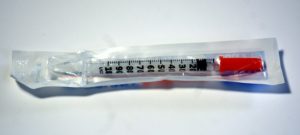Diabetic Ketoacidosis (DKA, Diabetic Acidosis) — Symptoms and Management
In Lecturio. Diabetic ketoacidosis is a common problem in type 1 diabetics and can be the presenting feature of newly-diagnosed diabetes. The typical patient with diabetic ketoacidosis is an adolescent or a child who is ill and who is presenting to the emergency department. In this article, you will gain a great overview of the diabetic management at the emergency department.
Table of Contents
Are you more of a visual learner? Check out our online video lectures and start your Emergency Medicine course now for free!

Definition
Diabetic ketoacidosis is the acute state of severe uncontrolled diabetes characterized by hyperglycemia (>11 mmol/L), ketonemia (>31 mg/ml)/ ketonuria (3+) and acidosis (pH <7.3).The condition requires treatment with insulin and intravenous fluids.
Epidemiology of Diabetic Ketoacidosis
Diabetic ketoacidosis is the presenting feature of newly-diagnosed diabetes mellitus in up to 50% of the cases among children but represents only 1-2 % of all other age groups.It has been previously reported that each year, 15,600 children in the United States develop type 1 diabetes.
The estimated number of cases of diabetic ketoacidosis in the United States is around 100,000 per year. Patients with a previous diagnosis of type 1 diabetes have an annual incidence of 1 to 10% of developing diabetic ketoacidosis.
The economic burden of diabetic ketoacidosis on the healthcare system is enormous. More than 2.5 billion dollars are spent yearly for the emergency management of diabetes and its complications in children in the United States.
The mortality rate was 100% before the discovery of insulin but currently stands at 1%. Diabetic ketoacidosis is the leading cause of death in children with type 1 diabetes. Patients with diabetic ketoacidosis who develop cerebral edema are at the highest risk of dying during the episode.
Pathophysiology of Diabetic Ketoacidosis
Upon the inciting event such as absolute insulin deficiency, there is increased levels of extracellular glucose and the body detects deficiency in glucose for usage by the cell. This triggers activation of the counterregulatory hormones epinephrine, cortisol and growth hormone that promote glycogenolysis, gluconeogenesis and lipolysis worsening the hyperglycemia and releasing free fatty acids into circulation.The FFA are broken down into ketone bodies such as acetone, aceto acetate and β-hydroxybutyrate. These are excreted in exhaled air as the body tries to correct the metabolic acidotic states leading to the characteristic fruity acetone smell and kussmall breathing.
When there is an imbalance between the amount of insulin in the blood and the counterregulatory hormones epinephrine, cortisol and growth hormone, the patient develops diabetic ketoacidosis. Patients with diabetic ketoacidosis have insulin deficiency combined with excessive production of the counterregulatory hormones. The overproduction of the counterregulatory hormones can be triggered by an acute illness or stress.
Patients with newly-diagnosed type 1 diabetes have absolute insulin deficiency. Those with an established diagnosis of type 1 diabetes who fail to take their insulin can also develop absolute insulin deficiency which can trigger an episode of diabetic ketoacidosis.
Diseases such as sepsis, febrile illnesses, vomiting and diarrhea are all associated with an increase in the levels of circulating counterregulatory hormones. This explains why such conditions might be associated with diabetic ketoacidosis.
Patients who have diabetic ketoacidosis have:
- increased glycogenolysis and gluconeogenesis
- impaired utilization of glucose by peripheral tissues
- excessive production of ketones by the liver
Patients with diabetic ketoacidosis develop severe dehydration, metabolic acidosis, hyperglycemia, and serum electrolyte abnormalities. The correction of these changes is what the management of diabetic ketoacidosis all about.
Clinical Presentation of Diabetic Ketoacidosis
Patients with diabetic ketoacidosis are usually children who are ill and unstable. They typically present with polyuria, polydipsia, nausea, vomiting, and abdominal pain. Patients are typically severely dehydrated and tachypneic. Because of the ketonemia, patients with diabetic ketoacidosis have a fruity-smelling breath. The level of alertness might be altered.The diagnosis of diabetic ketoacidosis is a laboratory-based diagnosis. The following points summarize the diagnostic criteria for diabetic ketoacidosis:
- A blood glucose level above 200 mg/dL or 11 mmol/L
- Venous pH less than 7.3 or bicarbonate less than 15 mEq/L (acidosis)
- Ketone bodies in the blood above 31 mg/dL (> 0.3 mmol/L) or ketonuria more than 80 mg/dL
- Severe diabetic ketoacidosis = pH < 7.1 or bicarbonate less than 5 mEq/L
- Mild diabetic ketoacidosis = pH between 7.2 to 7.3 and bicarbonate between 10 to 15 mEq/L
- Positive history of previous episodes of diabetic ketoacidosis
- Newly-diagnosed diabetes
- Poor metabolic control
- Noncompliance with insulin
- Eating disorders
- Female gender
Emergency Management of Diabetic Ketoacidosis
The emergency management of diabetic ketoacidosis includes three main components:- Fluid therapy
- Treating hyperglycemia with insulin therapy
- Correcting electrolyte disturbances
| Step 1 | Assess the airway, breathing, and circulation status of the patient |
| Step 2 | Assess the level of dehydration |
| Step 3 | Assess the risk for cerebral edema |
| Step 4 | Perform a mental status examination and determine the Glasgow Coma Scale score |
| Step 5 | Initiate cardiopulmonary monitoring and repeat vital signs assessment every 15 minutes |
| Step 6 | Secure two peripheral intravenous lines, one to withdraw blood and another for fluid therapy |
| Step 7 | Order the following laboratory tests: blood glucose, blood ketones, urine ketones, venous blood gases, electrolytes, calcium, magnesium, phosphate, a complete blood count, and HbA1C |
| Step 8 | Give intravenous fluids: normal saline at the dose of 10 mL/kg |
| Step 9 | Confirm the diagnosis of diabetic ketoacidosis based on the results of the above laboratory tests |
Rehydration Therapy for Diabetic Ketoacidosis
Give a second bolus of 10 mL/kg normal saline if needed and begin 1.5 to 2 times maintenance with normal saline using the following formula:
4 mL/kg for first 10 kg + 2 mL/kg for the next 10 kg + 1 mL/kg for the remainder of the patient’s weight.
Electrolyte Replacement Therapy for Diabetic Ketoacidosis
Based on the level of serum potassium at presentation, the necessity and amount of ordered KCL or KPhos can be calculated:| Serum level of potassium | |
| Less than 4 mEq/L | 30 mEq of KCL or KPhos to be added to the NS bag |
| Between 4 and 5.4 | 20 mEq of KCL or KPhos |
| Between 5.5 to 6 | 10 mEq of KCL or KPhos |
| Above 6 | Potassium replacement therapy is not needed. Because of the high risk of developing cardiac arrhythmias, electrocardiogram is indicated. |
Insulin Therapy for Diabetic Ketoacidosis
- Regular insulin at the dose of 0.1 unit per kgper hour after the initiation of fluid therapy
- Avoid insulin bolus
- Aim to lower glucose by 50 to 100 mg/dL per hour
- Two-bag system to titrate the amount of glucose given to the patient depending on the blood glucose level
Reassessment of Diabetic Ketoacidosis Patients at the Emergency Department
All patients with diabetic ketoacidosis should be on cardiorespiratory monitor. Heart rate, respiratory rate, blood pressure, and peripheral oxygen saturation need to be checked every 15 minutes.Moreover, the following assessment tools need to be repeated per the following recommendations:
- Blood glucose level to be checked every hour
- Serum electrolytes to be checked every two hours
- Neurological examination to be repeated every hour
Risk Factors for Cerebral Edema in Diabetic Ketoacidosis
Cerebral edema is the leading cause of morbidity and mortality in diabetic ketoacidosis. It typically occurs within 4 to 12 hours after treatment is initiated.The main risk factors for cerebral edema are:
- Age less than 3 years
- Previous history of diabetic ketoacidosis
- A pH less than 7.0
- Administration of bicarbonate
- An elevated level of blood urea nitrogen at presentation
- Low PaCO2 levels at presentation
- Initial blood glucose above 1000 mg/dL
Major Criteria:
- Glasgow Coma Scale equal to or less than 13
- Decline in baseline heart rate by 20 beats per minute
- Age-inappropriate incontinence
- Vomiting
- Headache
- Lethargy
- Diastolic blood pressure above 90 mmHg
- Age less than 5 years

Este comentário foi removido por um gestor do blogue.
ResponderEliminar